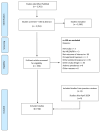Long-term exposure to elemental carbon and disease incidence: a systematic review and meta-analysis
- PMID: 40713661
- PMCID: PMC12291253
- DOI: 10.1186/s12940-025-01209-z
Long-term exposure to elemental carbon and disease incidence: a systematic review and meta-analysis
Abstract
Introduction: Epidemiological studies have documented the health effects of long-term exposure to fine particulate matter, while there is a growing number of studies looking into associations with one of its main components elemental carbon (EC) and its related metrics such as black carbon (BC), black smoke (BS) or aerosol light absorption coefficient often referred as "PM absorbance". We performed a systematic review and meta-analysis on the associations between long-term exposure to elemental carbon (EC) and disease incidence.
Methods: We searched for studies published up to April 2025, assessing long-term to EC-related exposure (also including BC, BS, PM absorbance) and incidence of ischemic heart disease (IHD), asthma, chronic obstructive pulmonary disease (COPD) and lung cancer in adults, and asthma and acute lower respiratory infections (ALRI) in children. We pooled effect estimates by random-effects models and investigated heterogeneity by region and risk of bias assessments. The certainty of the evidence was assessed using the Grading of Recommendations Assessment Development approach.
Results: We included 51 studies assessing long-term exposure to EC and disease incidence. The pooled relative risk (RR) for a 1 µg/m3 increase in EC was 1.10 (95% confidence interval (CI): 1.04, 1.17), 1.11 (95% CI: 1.00, 1.05), for incidence of lung cancer and IHD in adults, while a null association was observed for COPD risk. We estimated RR 1.06 (95% CI: 0.94, 1.21) and 1.37 (95% CI: 0.89, 2.04) for asthma and ALRI in children respectively. There was moderate to high heterogeneity in all associations, with the exception of lung cancer incidence for which the certainty of evidence was rated high.
Conclusions: Our meta-analysis supports an increased risk of lung cancer following long term exposure to EC and indicates associations for IHD in adults and respiratory outcomes in children. Although the evidence base on the effects of EC on diseases incidence has been increasing, further research is needed in the associations between long- term exposure to EC and various diseases' incidence.
Keywords: Elemental carbon; Incidence; Long-term exposure; Meta-analysis.
© 2025. The Author(s).
Conflict of interest statement
Declarations. Ethics approval and consent to participate: Not applicable. Consent for publication: Not applicable. Clinical trial number: Not applicable. Competing interests: The authors declare no competing interests.
Figures



References
-
- Sang S, Chu C, Zhang T, Chen H, Yang X. The global burden of disease attributable to ambient fine particulate matter in 204 countries and territories, 1990–2019: A systematic analysis of the global burden of disease study 2019. Ecotoxicol Environ Saf. 2022;238:113588. - PubMed
-
- 16909 E. Ambient air – Measurement of elemental carbon (EC) and organic carbon (OC) collected on filters. Brussels: CEN; 2017.
-
- Petzold A, Ogren JA, Fiebig M, Laj P, Li SM, Baltensperger U, Holzer-Popp T, Kinne S, Pappalardo G, Sugimoto N, et al. Recommendations for reporting black carbon measurements. Atmos Chem Phys. 2013;13(16):8365–79.
-
- Cyrys J, Heinrich J, Hoek G, Meliefste K, Lewné M, Gehring U, Bellander T, Fischer P, van Vliet P, Brauer M, et al. Comparison between different traffic-related particle indicators: elemental carbon (EC), PM2.5 mass, and absorbance. J Expo Anal Environ Epidemiol. 2003;13(2):134–43. - PubMed
-
- Janssen NA, Hoek G, Simic-Lawson M, Fischer P, van Bree L, ten Brink H, Keuken M, Atkinson RW, Anderson HR, Brunekreef B, et al. Black carbon as an additional indicator of the adverse health effects of airborne particles compared with PM10 and PM2.5. Environ Health Perspect. 2011;119(12):1691–9. - PMC - PubMed
Publication types
MeSH terms
Substances
Grants and funding
LinkOut - more resources
Full Text Sources
Miscellaneous

